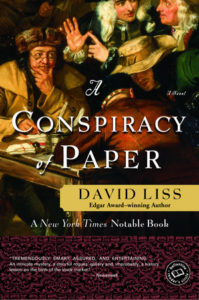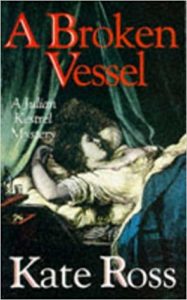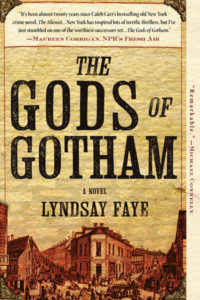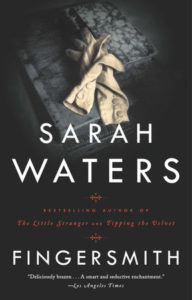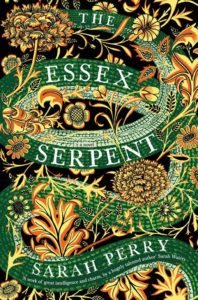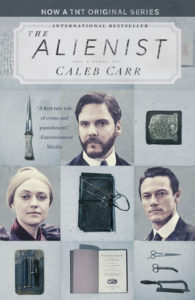History is a collection of stories. Unfortunately, when I was a child, I found those stories were pretty poorly written. They certainly didn’t capture my imagination or hold my attention, anyway. I remember spending long hours in the library at my prep school, trying to remember the sequence of battles in the Crimean War. British schools teach British history, of course, and tend to focus on the history of imperialism, which means my head was already crammed with the names and dates of that period. I suppose I was just looking for the spark to set it all alight in my mind. George MacDonald Fraser did exactly that, with his Flashman novels, followed by Bernard Cornwell, whose character Richard Sharpe rises through the ranks of Queen Victoria’s army and fights his way through India and the Napoleonic Wars.
It didn’t take me long to find out there was an intersection of crime fiction and historical fiction. One of the most fascinating elements of this literary hybrid is its ability to show the reader not just what the world was like in a given period, but how social change was being effected at the time. And what impact those changes had on real people. Crime highlights the change in relationships wrought by the rise of the British Empire and the concurrent revolution in Industry. Prior to this, we were certainly nasty to each other on a national and tribal basis, but we were usually nice to our neighbors. Communities were small, we all knew each other and potentially dangerous outsiders were carefully watched.
The Industrial Revolution and the Rise of Empire changed all of that. It disrupted everything from the village to society at large. It threw peoples together and put them in conflict with each other. It tore up the social order, enforced migration, grew the cities, shrunk the countrysides and changed the way entire nations worked and lived. Society was traumatized, and the result was a dramatic increase in criminal activity, including murder. Small wonder it provided such a rich seam for novelists, then and now, to mine!
Here’s a list of some of my favorite crossover mysteries from the late 18th through to the late 19th century, each illustrating another piece in the time period’s vast changes in industry and empire. A top ten historical mysteries, if you will. In historical order, of course!
The Queen of Bedlam, by Robert McCammon (set in 1703)
In the early 1700s, New York was unquestionably a British city. But there were plenty of undercurrents of discontent that heralded the Revolution. There were still plenty of Dutch in New York, and they resented their British overlords. Ten years earlier, a German merchant names Leisler had led a rebellion that ended in his forces occupying the city for a time, before Leisler was arrested and hanged. These tendrils of unrest become manifest in the Queen of Bedlam in the form of class resentment, serial murder and insanity. In the novel, a young magistrate’s clerk is hunting a serial killer called The Masker, who targets wealthy businessmen. The trail twists and turns through the parlors and backstreets of colonial Manhattan and ends up in a mental institution.
A Conspiracy of Paper, by David Liss (set in 1720)
This is the first historical novel that I read about finance in the 18th century. I actually stumbled upon it while I was researching a non-fiction project about the creation of the New York Stock Exchange. I was looking into the way markets were formed in Europe, and this recommendation popped up. London in the 1720s was gripped and roiled by the South Sea Bubble, one of the greatest financial scandals of all time. I was surprised at what a great read it was, but I loved the character of Benjamin Weaver, a Jewish former boxer. I also loved the descriptions of London, and the contracts between the east and west ends.
The Devil in the Marshalsea, by Antonia Hodgson (set in 1727)
A Conspiracy of Paper may have piqued my interest in historical fiction, but it was The Devil in the Marshalsea that really convinced me to start writing it myself. One of the features of the 18th century world was the lack of regulation of business. Pretty much the only rule was that you had to pay your debts, and if you couldn’t, you went to jail. Everything else was up to the individual. The result, naturally, was an orgy of conning, duping and cheating that resulted in lots of people going bankrupt … and going to jails like the Marshalsea, where Charles Dickens’ father was incarcerated. Debtors prisons existed in Britain until the early 1900s, and in the US until the mid 1800s. The Devil in the Marshalsea describes the debtors prison at its worst, in the early 1700s. It’s a corker of a whodunit, with superb characters and wonderful descriptions of London’s colorful underworld.
Golden Hill, by Francis Spufford (set in 1747)
You might call the mid 1700s the peak of British rule in New York. The King was making money hand over fist from the colonial trade, and from the onerous taxes that would eventually result in the Boston Tea Party and the Revolutionary War. The feeling in Francis Spufford’s first novel is of a city on the brink of something dangerous, with its complacent citizenry blissfully unaware of the upheaval soon to follow. I found the novel tough to get into, initially, because Spufford uses such archaic language. But once I got used to that, the story really took off. It’s about a strange man who arrives in the city with a great deal of money—or so he claims. I was hooked from the moment the mystery man exchanged his four gold coins for local money, which was a mismatch of random coinage and scrip issued by various states. Having just done a great deal of research on coinage of the time, I appreciated Spufford’s meticulous rendering of the scene and his attention to detail.
A Broken Vessel, by Kate Ross (set in the 1820s)
This is the second of Kate Ross’ series of novels featuring her gentleman sleuth Julian Kestral, who swans about solving crimes in London in the 1820s. It’s the first of the series that I picked up, which is perhaps why it’s my favorite, but I also think she really hits her stride in this one. I love it because of the liberal use of cant, the language used by Londoners in the underworld. The 1820s were a fascinating time in England. George III had died, and the Prince Regent became George IV. The arts, fashion and cultural pursuits flourished under this flamboyant, exuberant ruler, but it wasn’t all roses. There was enormous economic upheaval due to the wars with Napoleon, and the gap between rich and poor grew wider and more stark as the years went on. London became famous for its slums and its underworld, which Kate Ross has great fun exploring in this series, which is replete with lively characters, not least Julian Kestral himself.
The Gods of Gotham, by Lyndsay Faye (set in the 1860s)
I had already written the first draft of The Devil’s Half Mile when someone mentioned The Gods of Gotham to me. I grabbed it up, and tore through it. It is a breath-taking ride, and one that I’m glad I didn’t take before I started writing myself. If I had, I might not have started at all. Instead, it’s the book that has convinced me to keep writing, in the hope that I can produce something as good, one day. It’s a crime thriller, set in New York in the 1860, right about the point that the population of Manhattan hit a million. The feeling is of a city on the edge, a dangerous, frightening place, full of the most outrageous and colourful characters. And one of the best things about it is that it’s a great history lesson about the politics of the time. New York had just committed to create and maintain a police force, which was a highly controversial idea back then. But it was inevitable, given the state of the city. It was expanding by the thousands every week, and the competition for resources, work and accommodation was intense.
Fingersmith, by Sarah Waters (set in the 1860s)
Sarah Waters has a PhD in Victorian literature, so you know you’re getting the goods with this one. It’s a hefty tome, 511 pages, but it’s full of twists and turns and double-crosses, and fabulous descriptions of 1860s London and its demi-monde. Female sexuality and identity are big themes, but they never eclipse the characters or make you feel like you’re reading anything but a cracking story. It’s set in one of the most revolutionary periods of social and sexual history, right at the time when John Stuart Mill was campaigning for Parliament on a platform of votes for women and equality of the sexes. This is the age of Florence Nightingale, Harriet Martineau, and Josephine Butler, and the feeling of change permeates every page of Waters’ novel.
The Essex Serpent, by Sarah Perry (set in the late 1800s)
This is a deep one. I picked this up after I read a review in The Guardian. I was a bit intimidated (it’s 441 pages long) but it’s a beautifully written tale of Victorian London in the late 1800s. It’s stuffed with fascinating characters: a widow with an autistic son, a socialist maid, a tortured surgeon. This is a period of darkness and light in England. The London School of Economics opened, horseless taxicabs began doing business in the city, and you could drive underneath the Thames River in the Blackwall Tunnel. But it was also the time of the Whitechapel murders, Irish terrorism and Jack the Ripper. Urban Britain was a gothic place, and The Essex Serpent, while set in rural England, fits right in, starting with a suspicious death and turning into a monster story. In every sense of the phrase.
The Cater Street Hangman, by Ann Perry (set in the late 1800s)
What lover of historical fiction doesn’t love Ann Perry? I was introduced to her by a neighbor, a former US Navy captain from Selma, Alabama. Why he loved mysteries set in late 1800s London I’ll never know, but he had a huge collection of Perry novels, and he drip-fed them to me over the years. This is one of the first he gave me. It’s also the first novel featuring Inspector Thomas Pitt, which, for me, makes it one of her best. Thanks to the aforementioned Whitechapel murders—most of which have now been attributed to Jack the Ripper—and the associated media attention, the London police was beginning to transform into an organized, professional outfit, supported by most newspapers and politicians. Funding from the government meant the police could be paid, and it became a popular second career for men who had served in Queen Victoria’s army. It also provided an opportunity for advancement for men of low social rank like Thomas Pitt, a gamekeeper’s son, who rises to the post of superintendent and gives him license to poke his nose into the lives of the wealthy and influential, which does not always go down too well.
The Alienist, by Caleb Carr (set in 1896)
It’s hard to talk about historical fiction without mentioning The Alienist. Set in New York, it relates the hunt for a depraved serial killer. A century earlier, New Yorkers had fought the establishment of a police force, arguing it would turn out to be just another standing army, and a threat to individual liberty. By 1896, that argument had been long forgotten. New York was such an enormous city, and so riddled with crime that, as in London, a police force had become regarded by almost everyone as a necessity. As the force grew in size and scope, so its techniques changed. The Alienist tells the tale of a man at the cutting edge of that change, using detection techniques like psychology and fingerprinting to catch his killer. It’s a famous book. But I’ll be honest, I did not find it easy. I had to give it three tries. It’s a dense read, with huge chunks of dialogue. One of those that people had to convince me to “push through.” And there are plenty of those people out there. The book has a huge fan following. I’ll let you decide if it’s worth the effort.



